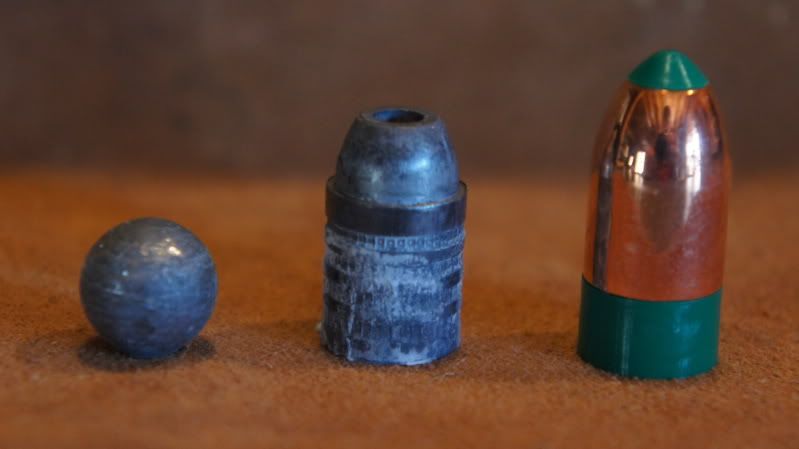Stupid question, but do you have to load it only when you're about to shoot? Or can you walk around with it ready to go?

My mama always said there's no stupid questions only stupid answers...so I'll lay out a basic primer for how a black powder gun operates.
First....clean, clean, clean...Black powder guns don't like gunk and to insure that no hang fire (doesn't go off when the trigger is pulled) occurs the barrel and touch hole are cleaned well before loading.
Second....charge the rifle with black powder. Black powder comes in different grains or coarseness's. FFFF, FFF, FF are the primary grains used for hunting. The lesser the number of Fs the coarser and more potent the powder is. So for hunting purposes we use FF for its more potent explosive capabilities. FFF is used for target and competition shooting as it is more consistent in performance. For hunting the rule of thumb is to use a charge, measured in grains, twice that as the calibre of the rifle. So if your using a .50 cal rifle you use 100 grs of FF black powder. Everything is measured with brass, horn or wood utensils so there is no chance for a spark. That would be bad.
Third...set the ball. Now you insert the ball into the snout of the barrel. The ball can be a traditional round ball that is surround with a greased cotton round patch. This patch acts as a sabot to tightly seal the projectile in the barrel. Or you could use a Maxi-ball, it looks like a circumference grooved bullet, with a good coating of grease. The Maxiball fits tighter than a round ball and only needs the grease to seal and the grease also helps ease the ramming of the ball down. These days I use a Powerbelt maxiball that has a plastic sabot at the balls bottom, this acts as the seal and is a more accurate projectile than the traditional balls. It also is easier to clean up after. Once you set the ball into the snout you use a small ramrod to initially start the ball down the barrel. This is mainly so you don't tweak your main, long ramrod and snap it in half trying to seat the ball. Once the ball is started and is approximately 6" down the barrel you use your main ramrod, which hitches a ride under the barrel of the gun, to firmly seat the bullet against the black powder charge. Failure to fully seat the ball will leave a cavity between the charge and the ball and will cause all kinds of bad things to happen as in a barrel explosion.
Fourth...Charge the gun. To fire the gun you need a primary explosion to ignite the charge in the barrel. On a percussion gun a small brass cap filled with powder fits over a nipple and is struck by the hammer to ignite the primary charge. On a flintlock this is done by putting a small amount of FFFF powder, it burns the fastest, in the frizzen pan. The frizzen pan is the lock mechanism where the flint holding hammer is. There is a depression in the frizzen pan that holds the powder and the striker closes over top of it to keep the powder in there. The striker is the surface the hammer hits to make a spark and ignite the powder in the frizzen pan. The hammer has a clamp which hold a piece of knapped flint, when the trigger is pulled the hammer falls causing the flint to spark off the striker while it pushes the striker plate back to expose the frizzen charge. The frizzen charge goes off, travels through the touch hole in the barrel and ignites the main charge within the barrel and out flies the ball. Dead deer walking...
Fifth...clean, clean, clean and reload. Experinced shooters can do this remarkablely fast, newbies are fun to watch.
Now as far as use the gun is loaded and charged when your hunting, There's is a charge in the barrel and powder in the frizzen. The hammer has three positions, Cocked, Half Cocked, and rest. Rest is the position when the hammer has no tension on it and rests down in the frizzen after it has been fired. Cocked is the hammer fully pulled back and ready to fire. Half cooked is where the gun is almost ready to go and is the position that is used while carrying the gun on a hunt. There are two triggers on a black powder rifle...the set and the fire triggers. To fire the gun you must pull back the hammer to the cocked position, pull the rear trigger, this is the set, to ready the fire trigger. Once the set trigger is engaged touching the firing trigger release the hammer and there's a loud report and white smoke everywhere. Fire triggers are normally hair triggers, but can be adjusted to suit the shooter.
So when your hunting the gun is loaded, there's powder in the pan, and the hammer is at half cocked. Rain or snow in the frizzen is bad, wet powder don't burn don't ya know. Spot deer, shoulder gun, cock hammer, set set trigger, touch off firing trigger, be temporarily blinded by smoke, go get deer, skin, butcher, package, freeze, thaw, cook ,eat. Such is life in the Pennsylvania woods. :elkgrin:


